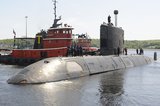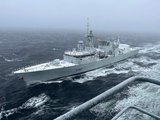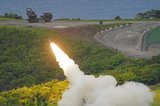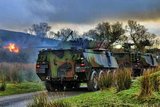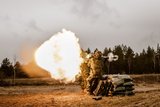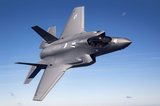Race to stop Norway frigate sinking after oil tanker collision
An operation was underway 8 November to try to stop a Norwegian navy frigate from sinking after it collided with a Maltese oil tanker in a fjord in western Norway.
Eight people received minor injuries in the accident, which took place shortly after 4:00 am (0300 GMT) in a busy waterway in the Hjeltefjord near Bergen, Norway's military said.
The 137 people on board the KNM Helge Ingstad frigate, which was returning from NATO's Trident Juncture exercises, were evacuated after the collision with the Sola TS tanker, the military said.
‘The KNM Helge Ingstad suffered damage above and below the waterline. The damage was such that the frigate was no longer stable and was not able to float sufficiently,’ a Norwegian Navy officer, Sigurd Smith, told reporters.
‘It was therefore decided to force it up on (nearby) rocks,’ he said.
In the early afternoon, the grey 5,000-tonne vessel was listing heavily on its side, its helicopter landing pad at the back of the ship lying largely under the water, television images showed.
‘It took on a lot of water and there is a real danger that it will sink where it is,’ an official for the Sola rescue centre told AFP.
The navy fears that the frigate will slip off the rocks and sink, with tugboats trying to keep it in place under the watchful eye of several Navy vessels.
‘We're trying to stabilise the ship on the rocks' in the hopes of refloating it, Navy Admiral Nils Andreas Stensones said.
‘According to our assessments, there's no reason to believe that anything, like an accident, could happen with the weapons’ on board, he said.
The cause of the accident was not yet determined, the navy said.
Meanwhile, the 62,000-tonne oil tanker, which was flying the Maltese flag but is owned by a Greek shipping company, was only slightly damaged and none of the 23 people on board were injured, the rescue centre said.
No leak from that vessel was reported.
A nearby oil terminal where the Maltese vessel had just loaded its cargo was closed to traffic on 5 November, in turn leading to a halt in production at five oil fields in the North Sea, according to business daily Dagens Naeringsliv.
Norway is the biggest oil producer in Western Europe.
The country's coast guard said meanwhile it had detected small diesel spills in the water and it was trying to contain further pollution. An anti-pollution ring was thrown up near the frigate to contain spills.
Norway's Accident Investigation Board, which has opened an inquiry, had initially said a tugboat had also been involved in the collision but the Navy later denied that.
Built in Spain in 2009, the KNM Helge Ingstad participated in chemical disarmament operations in Syria between December 2013 and May 2014.
More from Defence Notes
-
![How might European countries look to tackle drone incursions?]()
How might European countries look to tackle drone incursions?
Disruption of infrastructure in Europe, whether by cyberattack, physical damage to pipelines or uncrewed aerial vehicles flying over major airports, as has happened more recently, is on the rise. What is the most effective way of countering the aerial aspect of this not-so-open warfare?
-
![Taiwan approved for $11 billion weapon purchase from US]()
Taiwan approved for $11 billion weapon purchase from US
The US State Department’s approval of a multi-billion-dollar sale of weapons to Taiwan includes tactical mission networks equipment, uncrewed aerial systems, artillery rocket systems and self-propelled howitzers as well as anti-tank guided missiles.
-
![Ireland spells out $2.3 billion shopping list in five-year defence spending plan]()
Ireland spells out $2.3 billion shopping list in five-year defence spending plan
Ireland’s multi-annual investment in capital defence spending is set to rise from €300m in 2026 to €360m in 2029–2030 with major upgrades across land, air, maritime and cyber domains.
-
![Canada to deepen integration of multi-domain capabilities to strengthen its defences]()
Canada to deepen integration of multi-domain capabilities to strengthen its defences
The Canadian Department of National Defence has created new organisations to manage the procurement and integration of all-domain solutions and allocated US$258.33 million to strengthen production capacities.
-
![US National Security Strategy prioritises advanced military capabilities and national industry]()
US National Security Strategy prioritises advanced military capabilities and national industry
The 2025 NSS has emphasised investment in the US nuclear and air defence inventory and national industry, but it leaves multiple unanswered questions on how the White House will implement this approach.
-
![Canada set to look away from its neighbour and across the Atlantic for partners]()
Canada set to look away from its neighbour and across the Atlantic for partners
While non-EU UK struggles to join the Security Action for Europe initiative, which provides loans for defence programmes, Canada has become the first country outside Europe to get access – and did so for a nominal fee.









